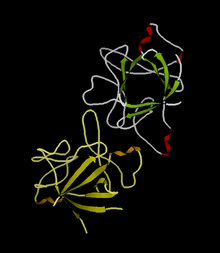|
阿那白滯素
阿那白滯素(Anakinra),以Kineret名稱出售。是一種治療類風濕性關節炎, 隱熱蛋白相關週期性綜合症、家族性地中海熱、成人史迪爾氏病的生物製藥[3]。是人類白細胞介素1受體拮抗劑蛋白质的重組及修改版本[3] It is marketed by Swedish Orphan Biovitrum.[1]。可由皮下注射[2]。 醫療用途在疾病緩解抗風濕藥治療失敗後,阿那白滯素被用作二線治療控制類風濕性關節炎[1][2]。可與某些DMARD結合使用[1][2][4]。 用於患有隱熱蛋白相關週期性綜合症的人,包括新生兒多系統炎症性疾病[1][2]。
已隱藏部分未翻譯内容,歡迎參與翻譯。 用於治療Schnitzler綜合症(在美國不符合標籤)。[5] Its response rate is such that it has been suggested that "Treatment failures should lead to reconsider the diagnosis."[6] 仿單標示外使用, it is used to treat 幼年特發性關節炎 (SJIA), 痛风, 二水合焦磷酸鈣晶體沉積病 (CPPD), 貝賽特氏症, 强直性脊柱炎, 葡萄膜炎, and other 自身炎症性疾病.[7] In December 2021, the 欧洲药品管理局 authorized the use of anakinra "to treat 2019冠状病毒病 in adults with pneumonia requiring supplemental oxygen (low or high flow oxygen) and who are at risk of developing severe respiratory failure, as determined by blood levels of a protein called suPAR (soluble urokinase plasminogen activator receptor) of at least 6 ng per ml."[3][8][9] In November 2022, the United States 美国食品药品监督管理局 approved its use under an 緊急使用授權 "for the treatment of COVID-19 in hospitalized adults with pneumonia requiring supplemental oxygen (low- or high-flow oxygen) who are at risk of progressing to severe respiratory failure and likely to have an elevated plasma soluble urokinase plasminogen activator receptor (suPAR)."[10][11] SafetyIt was not tested in pregnant women, but appeared to be safe in animal studies.[2] It should not be used in people who have active infections or latent tuberculosis, who have low 白血球 counts, or who are taking TNF inhibitors.[2] Adverse effectsMore than ten percent of people taking Anakinra have injection site reactions, headaches, and have increased cholesterol levels.[1] Between one and ten percent of recipients have severe infections, decreased white blood cells, or decreased 血小板.[1] It is unclear if taking Anakinra increases cancer risk; studies are complicated by the fact that people with rheumatoid arthritis already face higher cancer risk.[1][4] ChemistryAnakinra differs from the sequence of Interleukin 1 receptor antagonist by one 甲硫氨酸 氨基酸 added to its N端; it also differs from the human protein in that it is not 醣基化, as it is 工业发酵 in 大腸桿菌.[2] HistoryIt was approved for medical use in the US in 2001,[2] and in the European Union in 2002.[1][3] In 2018, NHS England published a Clinical Commissioning Policy: Anakinra to treat periodic fevers and autoinflammatory disorders (all ages) allowing Anakinra to be commissioned as a first-line treatment for Schnitzler's syndrome and in cases where the first-line treatment is not effective for Familial Mediterranean fever, Hyper-IgD syndrome also known as Mevalonate kinase deficiency, and TNF receptor associated periodic syndrome (TRAPS),[12] and a Clinical Commissioning Policy: Anakinra/tocilizumab for the treatment of Adult-Onset Still's Disease refractory to second-line therapy (adults), allowing Anakinra to be commissioned for adult-onset Still's disease "as a third line treatment where patients are refractory to steroid-sparing effect DMARDs".[13] In December 2020, Anakinra was approved by the US Food and Drug Administration for the treatment of deficiency of the interleukin-1–receptor antagonist (DIRA), a rare autoinflammatory disease of infancy.[14] In 2021, it was announced that the 俄罗斯联邦卫生部 had approved the use of Anakinra for the treatment of CAPS.[15] In October 2021, NHS England published Clinical Commissioning Policy: Anakinra for Haemophagocytic Lymphohistiocytosis (HLH) for adults and children in all ages, allowing Anakinra to be used in the treatment of HLH.[16] Society and cultureLegal status
ResearchAnakinra effectively treated meningitis caused by a rare genetic mutation in the gene NALP3 in a 67-year-old man enrolled in the Undiagnosed Diseases Network.[17] Researchers at 约翰斯·霍普金斯大学 announced in 2019 that anakinra given to pregnant mice with 茲卡病毒 had reduced fetal deaths and birth defects.[18] In November 2019, researchers at the 曼彻斯特大学 reported that Anakinra might have a use in preventing breast cancer from spreading to the bones.[19][20] In 2021, it was reported that Anakinra appeared to reduce the 神經性疼痛 experienced by patients undergoing 化学疗法 with 长春新碱, saying that "repurposing anakinra may be an effective co-treatment strategy to prevent vincristine-induced peripheral neuropathy".[21][22] A review published in 2022 found that "Anakinra appears to show efficacy for numerous 皮肤病学 conditions, with the strongest evidence for hidradenitis suppurativa, 貝賽特氏症, Muckle–Wells syndrome, and SAPHO syndrome." and concluded that "Overall, anakinra appears to be a promising option in the treatment of numerous dermatologic inflammatory conditions refractory to first line therapies, but further and higher-quality data is needed to clarify its therapeutic role."[23] In 2023, researchers at 哥伦比亚大学 explored the effect of Anakinra on the ageing of 造血干细胞s in mice. They concluded "that targeting IL-1 as a key mediator of niche inflammation is a tractable strategy to improve blood production during ageing" and were reported to have said "that their findings could pave the way for science to delay aging and even lengthen the lifespan of humans".[24][25][26] COVID-19
Anakinra is undergoing multiple clinical trials to treat 2019冠状病毒病 patients, by targeting mechanisms in patients with hyperinflammation.[27] In 2021 a review and 元分析 of 9 studies involving 1,119 cases concluded that "Available evidence shows that treatment with anakinra reduces both the need for invasive mechanical ventilation and mortality risk of hospitalized non-intubated patients with COVID-19 without increasing the risk of adverse events."[28] 截至2021年7月[update], the 欧洲药品管理局 (EMA) is evaluating an application to extend the use of anakinra to include treatment of 2019冠状病毒病 in adults with pneumonia who are at risk of developing severe respiratory failure (inability of the lungs to work properly).[29] According to study results published in September 2021 in 自然-医学, hospitalized COVID-19 patients at increased risk for 呼吸衰竭 showed significant improvement after treatment with Anakinra.[30][31] 參考
外部鏈接 |
||||||||||||||||||||||||||||||||||||||||||||||||||||||||||||||||||||||||||||||||||||||||||||||||||||||||||||||||
Portal di Ensiklopedia Dunia
